Staff Feature
O’Bannon Woods State Park
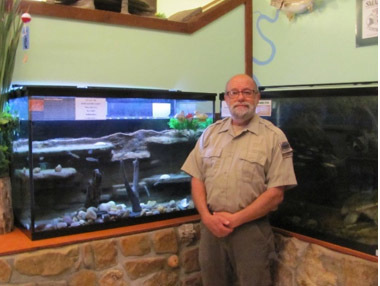 Jim Lynch is the intermittent naturalist at O’Bannon Woods State Park. He started his career with Indiana State Parks in 2007, as a gatehouse attendant. He did a lot of great work as a CRR-Trail Worker, placing over half of the gravel on the new Tulip Valley Universal Accessible Trail. He eventually found his calling as an intermittent naturalist. His daily duties include feeding and maintaining the hellbenders, snakes and other Indiana native animals that are on display. He even gives programs with the haypress and oxen, which is his favorite experience working for State Parks. When he’s not working with animals, Jim enjoys wood carving, bug/insect photography, fishing, and gardening, and he is an amateur botanist. Jim Lynch is the intermittent naturalist at O’Bannon Woods State Park. He started his career with Indiana State Parks in 2007, as a gatehouse attendant. He did a lot of great work as a CRR-Trail Worker, placing over half of the gravel on the new Tulip Valley Universal Accessible Trail. He eventually found his calling as an intermittent naturalist. His daily duties include feeding and maintaining the hellbenders, snakes and other Indiana native animals that are on display. He even gives programs with the haypress and oxen, which is his favorite experience working for State Parks. When he’s not working with animals, Jim enjoys wood carving, bug/insect photography, fishing, and gardening, and he is an amateur botanist. |
Clifty Falls State Park
Celebrating 100 Years
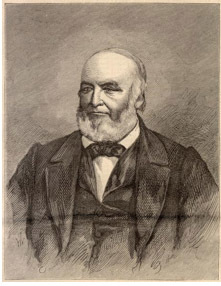
Brough’s Folly Brough’s Tunnel at Clifty Falls State Park was built in 1852. John Brough (September 17, 1811 – August 29, 1865) served as the president of the Madison and Indianapolis Railroad Company. He was a journalist, publisher, and politician in Ohio before coming to Indiana to work in the railroad business. Brough was born in Marietta, Ohio just two years after Ohio statehood. Young John was orphaned at age 11 and by age 12 he was working as an apprentice at the local newspaper. After gaining some skills and experience, he landed a job with a newspaper in Athens, Ohio. Brough had some success as a journalist and went into business with his brother to purchase several newspapers. Through his work as a journalist, Brough became involved in Ohio politics and was elected to its legislature in 1838. In 1839, he was elected to serve as state auditor for six years. In the mid-1840s, Brough moved to Indiana to work for the Madison and Indianapolis Railroad, becoming president of the company in 1848. During his time in Madison, the city raised its profile as a national center of pork packing. The railroads were essential to the pork industry, allowing farmers to transport their hogs to market. Stiff competition among railroads inspired Brough to build a tunnel through Madison’s rugged terrain to shorten the route to Indianapolis. The tunnel project was an effort to make the railroad company more competitive and profitable but was a gamble that did not pay off. A year into the $300,000 (in 1850s dollars) project, Brough admitted serious cost overruns of $115,000. The project was abandoned after money ran out and became known as Brough’s Folly. After this failure, Brough returned to Ohio to serve as its governor during the latter years of the Civil War. He took office in 1864 but died in 1865 before he could finish his term. Clifty Falls State Park is fortunate to be home to Brough’s Folly. It is an important part of the park’s trail system, helping families make memories for the past century. |
Clifty Inn
| Clifty Falls State Park opened to the public in 1920. Within a few years, the Clifty Inn opened, providing guests with a comfortable place to stay and wonderful views of the Ohio River. The first inn was a stone farmhouse that predated the park. Having been renovated and adapted, it was converted for use as the park’s hotel. | 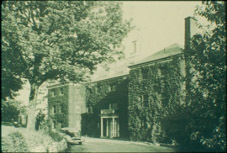 |
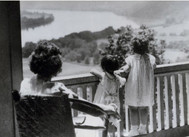 Later, the park built a new structure, and the original inn became an annex for the newer hotel. This inn was replaced by modern motel style lodgings in 1964. Only 10 years later, in 1974, a devastating Super Outbreak tornado tore through Madison and badly damaged the inn, but the park repaired and rebuilt the hotel. Clifty Inn underwent an upgrade in 2006 and continues to provide guests with a comfortable place to stay and picturesque views of the Ohio River. Later, the park built a new structure, and the original inn became an annex for the newer hotel. This inn was replaced by modern motel style lodgings in 1964. Only 10 years later, in 1974, a devastating Super Outbreak tornado tore through Madison and badly damaged the inn, but the park repaired and rebuilt the hotel. Clifty Inn underwent an upgrade in 2006 and continues to provide guests with a comfortable place to stay and picturesque views of the Ohio River. |
IMN Program with Youth
 The mission of the Indiana Master Naturalist (IMN) program is to bring together natural resource specialists with adult and youth learners. The hope is to foster an understanding of Indiana’s plants, water, soils, and wildlife, and promote natural resource volunteer service. IMN classes are found around the state. All classes offer a minimum of eight sessions of three hours each that focus on Indiana’s natural resources. Class sessions relate to botany, zoology, geology/soils, water, people, and natural resources. The class instructors provide field and hands-on experience while teaching. The mission of the Indiana Master Naturalist (IMN) program is to bring together natural resource specialists with adult and youth learners. The hope is to foster an understanding of Indiana’s plants, water, soils, and wildlife, and promote natural resource volunteer service. IMN classes are found around the state. All classes offer a minimum of eight sessions of three hours each that focus on Indiana’s natural resources. Class sessions relate to botany, zoology, geology/soils, water, people, and natural resources. The class instructors provide field and hands-on experience while teaching.
To obtain an IMN certification, participants must take the class, a test, and do volunteer work. Recently, adult IMNs helped Junior and Teen IMNs plant 20 trees at Ouabache State Park. Ten red cedars were placed near the shoreline of Lake Kunkel to help deter geese. The adults and youth were given a lesson on how to properly plant a tree. With adult guidance, the youth completed their service project. Each child is to take care of their tree to complete their volunteer time. Not only did the youth get the satisfaction of helping the park, park guests will get to enjoy the trees for years to come. IMNs young and old provide help at parks and for other natural resource organizations. Would you like to try the program? Learn more at at www.indianamasternaturalist.org. |
Amazing Milkweed
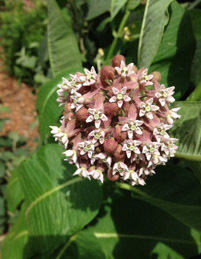 Milkweed is a plant more people are becoming familiar with. For years, it was considered just another weed but not anymore. Milkweed is the only host plant to the monarch butterfly. Monarchs lay their eggs on milkweed. Once hatched, the monarch caterpillar feeds only on milkweed. Milkweed is an essential plant to the monarch’s survival. Milkweed is a plant more people are becoming familiar with. For years, it was considered just another weed but not anymore. Milkweed is the only host plant to the monarch butterfly. Monarchs lay their eggs on milkweed. Once hatched, the monarch caterpillar feeds only on milkweed. Milkweed is an essential plant to the monarch’s survival.
Milkweed has beautiful blooms that smell like lilac. The flowers are favorites for many native pollinators. Those wanting to learn about pollinators need only to find a milkweed plant flowering and observe it. Common milkweed, Asclepias syriaca, is the species often seen along roadside and in state parks. Butterfly weed, swamp milkweed, and whorled milkweed are others commonly seen. Milkweed is just one of the many flowers that can be seen in several state park pollinator gardens. Next time you see a milkweed plant, take some time to watch the activity on and around it. If you are lucky, you may find a monarch caterpillar. |
|
Staff Feature |
O’Bannon Woods State Park
Clifty Falls State Park
Celebrating 100 Years
 Brough’s Folly Brough’s Folly
Brough’s Tunnel at Clifty Falls State Park was built in 1852. John Brough (September 17, 1811 – August 29, 1865) served as the president of the Madison and Indianapolis Railroad Company. He was a journalist, publisher, and politician in Ohio before coming to Indiana to work in the railroad business. Brough was born in Marietta, Ohio just two years after Ohio statehood. Young John was orphaned at age 11 and by age 12 he was working as an apprentice at the local newspaper. After gaining some skills and experience, he landed a job with a newspaper in Athens, Ohio. Brough had some success as a journalist and went into business with his brother to purchase several newspapers. Through his work as a journalist, Brough became involved in Ohio politics and was elected to its legislature in 1838. In 1839, he was elected to serve as state auditor for six years. In the mid-1840s, Brough moved to Indiana to work for the Madison and Indianapolis Railroad, becoming president of the company in 1848. During his time in Madison, the city raised its profile as a national center of pork packing. The railroads were essential to the pork industry, allowing farmers to transport their hogs to the market. Stiff competition among railroads inspired Brough to build a tunnel through Madison’s rugged terrain to shorten the route to Indianapolis. The tunnel project was an effort to make the railroad company more competitive and profitable but was a gamble that did not pay off. A year into the $300,000 (in 1850s dollars) project, Brough admitted serious cost overruns of $115,000. The project was abandoned after the money ran out and became known as Brough’s Folly. After this failure, Brough returned to Ohio to serve as its governor during the latter years of the Civil War. He took office in 1864 but died in 1865 before he could finish his term. Clifty Falls State Park is fortunate to be home to Brough’s Folly. It is an important part of the park’s trail system, helping families make memories for the past century. |
Clifty Inn
| Clifty Falls State Park opened to the public in 1920. Within a few years, the Clifty Inn opened, providing guests with a comfortable place to stay and wonderful views of the Ohio River. The first inn was a stone farmhouse that predated the park. Having been renovated and adapted, it was converted for use as the park’s hotel. |  |
 Later, the park built a new structure, and the original inn became an annex for the newer hotel. This inn was replaced by modern motel-style lodgings in 1964. Only 10 years later, in 1974, a devastating Super Outbreak tornado tore through Madison and badly damaged the inn, but the park repaired and rebuilt the hotel. Clifty Inn underwent an upgrade in 2006 and continues to provide guests with a comfortable place to stay and picturesque views of the Ohio River. Later, the park built a new structure, and the original inn became an annex for the newer hotel. This inn was replaced by modern motel-style lodgings in 1964. Only 10 years later, in 1974, a devastating Super Outbreak tornado tore through Madison and badly damaged the inn, but the park repaired and rebuilt the hotel. Clifty Inn underwent an upgrade in 2006 and continues to provide guests with a comfortable place to stay and picturesque views of the Ohio River. |




